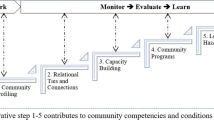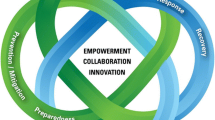Abstract
Perception about people’s behaviour during emergencies defines, to a large extent, the course of planning and resource allocation for community emergency response as well as development of mitigation measures. During the past decade, there has been a paradigm shift in the approach to disaster management. A recent trend has been to encourage more community participation as opposed to the top-down approach of the past. It is believed that community participation will bring about a comprehensive and accurate appreciation of people’s perception regarding hazards, risk, vulnerability, and resilience, and this research is an attempt to achieve just that. In order to accomplish our goal, we engaged a group of women that would typically fall into the category of “vulnerable group” in a focus group interview setting. The participants were mainly over 40 years old, the majority with little education, unemployed, facing language barriers, of low income, and reliant on public transit. Many participants identified that they lived in the vicinity of rivers, lakes, railways, or power plants, but did not seem to be aware of their exposure to potential threats—indicating a lack of education and awareness. The most common hazards and mitigation measures they were aware of, included floods (including basement flooding), fire, fire alarm, and smoke detectors. Additionally, illness and loneliness were mentioned as factors contributing to their increased vulnerability, hence reduced resiliency. With the help of the focus group members’ participation, we were able to discuss the importance of communities being aware of their surroundings, available resources and help, and permit them to voice their concerns in order to be able to cope during emergencies. We trust and hope that more community participation will lead to stronger and more resilient cities.






Similar content being viewed by others
References
Alexander D (2002) Principles of emergency planning and management. Oxford University Press, 340 p
Armenakis C, Nirupama N (2011) Prioritization of disaster risk in a community using GIS. Natural Hazards, Springer Submitted
Birkmann J (ed) (2006) Measuring vulnerability to natural hazards: towards disaster resilient societies. United Nations University Press, Tokyo, 524 p
Brown O, Crawford A, Hammill A (2006) Natural disasters and resource rights: building resilience, rebuilding lives. International Institute for Sustainable Development, Canada
Etkin D, Haque (2003) An assessment of natural hazards and disasters in Canada, Kluwer Academic, pp 211–589
FEMA (2011) http://ebookbrowse.com/chapter-8-myths-and-realities-of-household-dis-resp-doc-d140235505. Accessed 6 July 2011
Ferrier N, Haque E (2003) Hazards risk assessment methodology for emergency managers: a standardized framework for application. Nat Hazards 28:271–290
Green C (2004) The evaluation of vulnerability to flooding. Disaster Prev Manag 13(4):323–329
GTZ (2004) Guidelines risk analysis—a basis for disaster risk management. Federal Ministry for Economic Cooperation and Development, Eschborn
Helm P (1996) Integrated risk management for natural and technological disasters. Tephra 15(1):4–13
Hewitt K (1997) Regions of risk: a geographical introduction to disasters, Longman Pub Group, 389 p
HRVA (2004) http://www.pep.bc.ca/hrva/toolkit.html. Accessed on 10 Feb 2011
ISDR (2004) Living with risk: a global review of disaster reduction initiatives. United Nations. www.unisdr.org
ICSU (2008) A science plan for integrated research on disaster risk—addressing the challenge of natural and human-induced environmental hazards, International Council for Science, France
Jaeger CC, Renn O, Rosa EA, Webler T (2001) Risk, uncertainty, and rational action. Earthscan Publications, London
Mathew A, Kelly K (2008) Disaster preparedness in urban immigrant communities: lessons learned from recent catastrophic events and their relevance to Latino and Asian Communities in Southern California, The Tomás Rivera Policy Institute University of Southern California, School of Policy, Planning and Development, Los Angeles, California
Mileti DS (1999) Disasters by design. Joseph Henry Press, Washington
Nirupama N (2008) Disaster risk management: theory, practice and policy. Workshop report: public safety Canada, Government of Canada, Ottawa
NVivo (2009) www.qsrinternational.com
Olanubi T (2009) Crisis management and psychosocial intervention: perception of immigrants, Major research paper, MA in disaster and emergency management, York University, Toronto
PSC—Public Safety Canada (2011) http://www.publicsafety.gc.ca/prg/em/cdd/srch-eng.aspx. Accessed on 12 Feb 2011
Slovic P (2000) The perception of risk. Earthscan publications, London
Smith K (2004) Environmental hazards. Assessing Risk and Reducing Disaster, Routledge
Stewart RM (2007) Community perspectives of flood risk and social vulnerability reduction: the case of the Red River Basin, Doctoral Thesis. Natural Resources Institute, University of Manitoba, Canada
Tierney KJ (1999) Toward a critical sociology of risk. Sociol Forum 14(2):215–242
Tobin GA, Montz BE (1997) Natural hazards: explanation and integration. Guilford Press, New York
Twigg J (2007) Characteristics of a disaster-resilient community. DFID Disaster Risk Reduction Interagency Coordination Group, 39 p. http://www.benfieldhrc.org/disaster_studies/projects/communitydrrindicators/community_drr_indicators_index.htm
United Nations International Strategy for Disaster Reduction (UNISDR) (2001) Targeting vulnerability: guidelines for local activities and events. UNISDR, Geneva
Whyte AV, Burton I (1982) Perception of risk in Canada. In: Burton I, Fowle CD, McCullough RS (eds) Living with risk. University of Toronto, Canada, pp 39–69
Wisner B, Blaikie P, Cannon T, Davis I (2004) At risk: natural hazards, people’s vulnerability and disasters, 2nd edn. Routledge, 471 p
Acknowledgments
The authors would like to thank Kripa Sekhar, Executive Director of the South Asian Women Centre for her support in facilitating the focus group interview session. The first author acknowledges the use the SSHRC funds towards engaging a graduate student for the study.
Author information
Authors and Affiliations
Corresponding author
Appendix
Appendix
1.1 Questionnaire
1.1.1 Demographic
The purpose of this section is to understand the structure and composition of the studied population.
-
1.
I am in the age bracket of:
-
2.
The highest level of education I have earned is:
-
3.
I am currently employed:
-
4.
If yes, the nature of my employment is:
-
5.
If yes (to #3), the organization I am employed with is:
-
6.
I classify my current job satisfaction as:
-
7.
My current marital status is:
-
8.
The number of members in my household is: ___. (Fill in the # of residents)
-
9.
What is the nature of the relationship of those members who reside in your household? (Circle all that apply and indicate how many of each).
-
10.
The type of my residence is:
-
11.
I have lived in Canada for: (Fill in the number)
-
12.
The country I migrated from is:
-
13.
When considering my English speaking fluency, my level is:
-
14.
My English reading skills are:
-
15.
My English writing skills are:
1.1.2 THEME 1: risk exposure
The purpose of this section is to understand the ways in which people, property, systems, or other elements present in hazard zones are subject to potential losses 1.
-
16.
I live in the vicinity of: (Circle all that apply: river, power plant, railway, chemical plant etc.).
-
17.
I am confident in my level of safety:
-
18.
I am regularly exposed to risk:
1.1.3 Theme 2: vulnerability
The purpose of this section is to understand the characteristics and circumstances of a community, system, or asset that makes it susceptible to the damaging effects of a hazard 2.
-
19.
I have experienced a disaster/emergency event:
-
20.
Rate the importance of preparedness for unforeseen hazard risks, to you.
-
21.
In case of emergency, I have the resources to find help from:
-
22.
My main and most frequent source of transportation is:
-
23.
As an immigrant, the biggest challenge I have faced is :
1.1.4 Theme 3: resiliency/capacity
The purpose of this section is to understand the ability of individuals and society faced with hazards to respond to and recover from the impact in a timely and efficient manner. The combination of all the strengths, attributes and resources available within a community, can be used for restoration of essential structure and function.
-
24.
I classify my health as:
-
25.
I have a disability:
-
26.
Provide a list of items in your house that will be helpful in case of an emergency:
1)
___________________________
6)
___________________________
2)
___________________________
7)
___________________________
3)
___________________________
8)
___________________________
4)
___________________________
9)
___________________________
5)
___________________________
10)
__________________________
-
27.
I am aware of community programmes that are beneficial to my healthy living, happiness, and safety:
-
28.
I participate in cultural events within my community:
-
29.
I feel a sense of belonging within my community:
-
30.
Rate the importance of social ties and socializing to you.
-
31.
I am interested of the current issues of my local government:
-
32.
I normally vote in municipal elections:
-
33.
I am involved in the activities that support my local government:
-
34.
Comment on how satisfied you are with your municipal political representative, or give suggestions for improvement.
-
35.
My religious affiliation is:
-
36.
My annual household income is:
Rights and permissions
About this article
Cite this article
Nirupama, N., Maula, A. Engaging public for building resilient communities to reduce disaster impact. Nat Hazards 66, 51–59 (2013). https://doi.org/10.1007/s11069-011-0045-9
Received:
Accepted:
Published:
Issue Date:
DOI: https://doi.org/10.1007/s11069-011-0045-9




